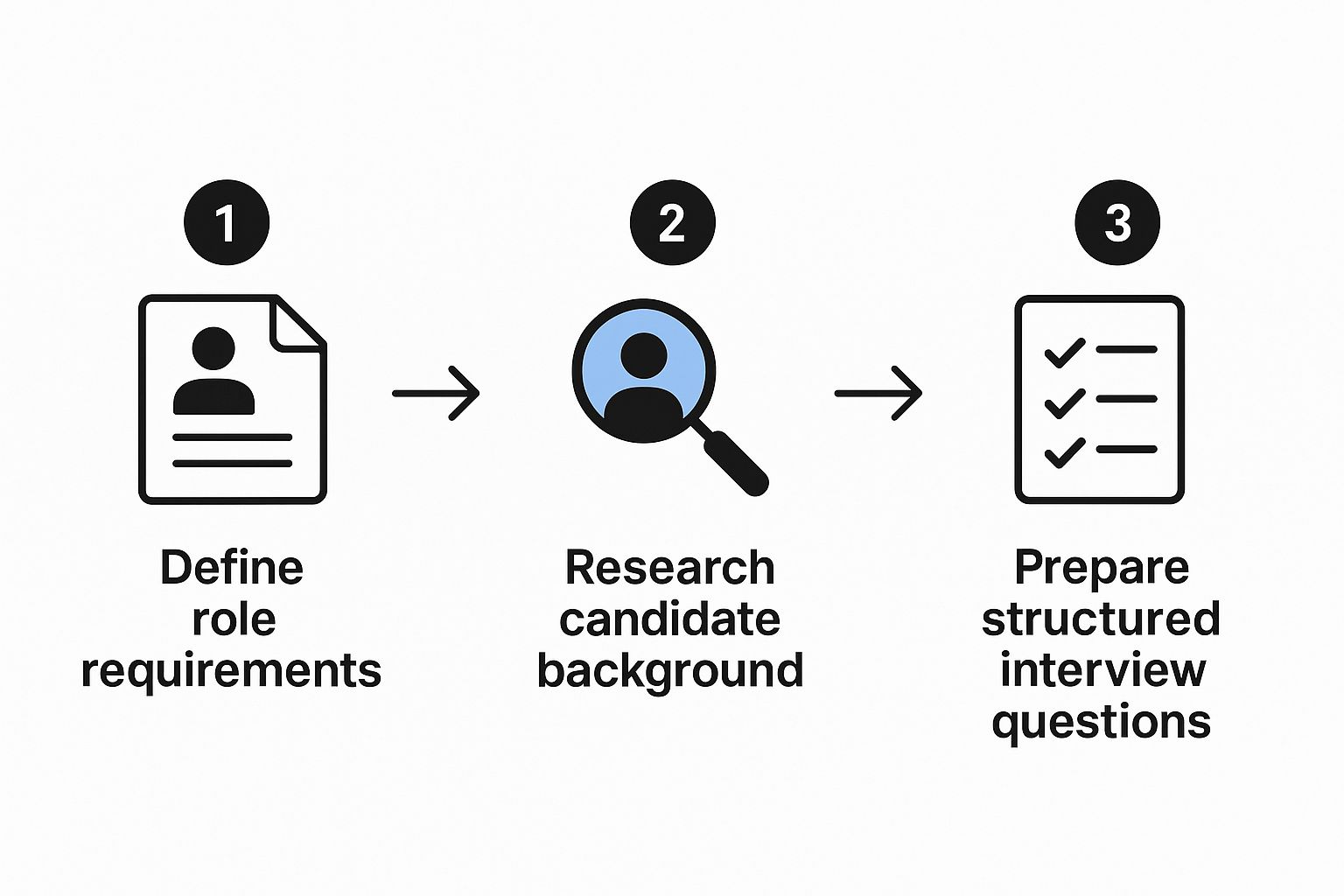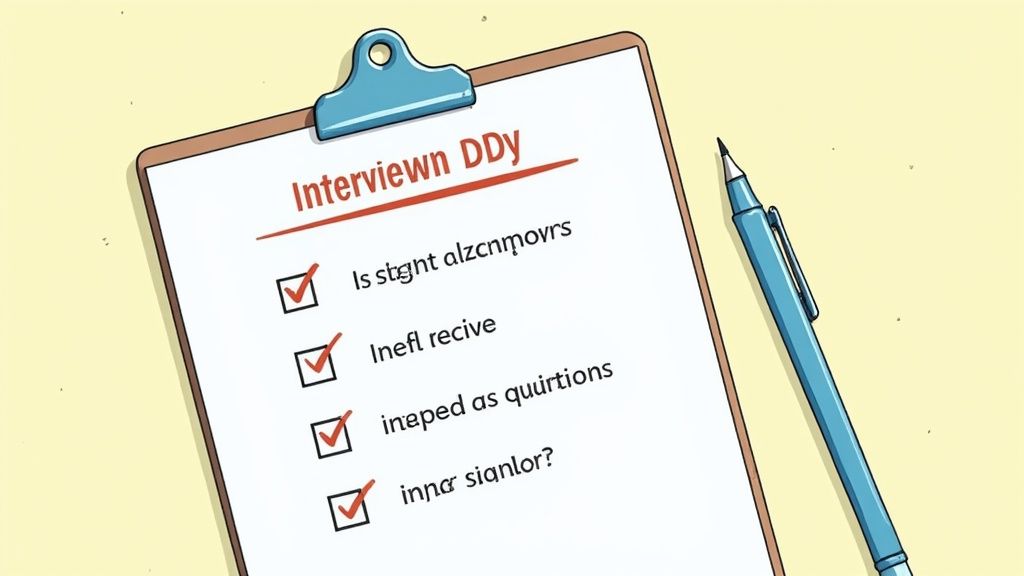
A Practical Hiring Manager Interview Guide
Published
A great hire doesn't just happen. The real work starts long before anyone walks into an interview room. This guide is all about laying that crucial groundwork, giving you a framework to look past the polished resumes and spot genuine talent. It all boils down to one thing: defining what success looks like before you even start searching.
Building Your Foundation for a Great Hire

I've seen it a hundred times: the single biggest hiring mistake is kicking off a search with a vague, copy-pasted job description. Forget that. Before you do anything else, you need to build a "success profile." Think of it as a detailed blueprint that outlines exactly what an amazing hire will accomplish in their first 90 days and beyond.
This profile becomes your true north for the entire hiring process. It stops you from getting sidetracked by a candidate's charisma or an impressive-sounding project on their resume. It’s not about finding someone who ticks a dozen boxes; it’s about finding the one person who can deliver the specific results you need.
Define Core Competencies, Not Just Skills
Your first move should be to sit down with your talent acquisition partner and go deeper than a simple skills checklist. Skills are what a person can do. Competencies are how they do it. This is a critical distinction.
For instance, instead of just listing "proficient in Google Analytics," a core competency might be "Data-Driven Decision Making." See the difference? One is about using a tool; the other is about interpreting data, finding insights, and building a business case from those numbers.
To nail these down, ask yourself a few questions:
- What really separates the top performers from the average ones on my current team? What do they do differently?
- What are the big challenges this new hire will face in their first six months? What abilities are non-negotiable for tackling them?
- Beyond the technical stuff, what soft skills are essential for someone to thrive with our team's unique dynamic?
A lot of these competencies circle back to core abilities. You can teach someone a new software program in a week, but teaching them initiative or how to communicate clearly is a much heavier lift. If you're looking to sharpen your own understanding, you can learn more about how to develop communication skills in our related guide and use those concepts to shape your criteria.
Visualize Success With a 90-Day Plan
Now, get practical. Create a clear outline of what this person needs to achieve. This isn't just a fluffy onboarding plan; it's a concrete performance benchmark.
A well-defined 90-day plan acts as a universal scorecard. It ensures you evaluate every candidate against the same set of critical outcomes, removing subjectivity and significantly reducing hiring bias.
Let’s say you’re hiring a Social Media Manager. A solid 90-day plan might look something like this:
- First 30 Days: Conduct a full audit of our current social channels. Present key findings and initial recommendations to the marketing team.
- First 60 Days: Launch and manage two new content campaigns. Deliver weekly performance reports with hard data on engagement and reach.
- First 90 Days: Propose a data-backed content strategy for the next quarter, complete with a budget and resource plan.
This outcome-based approach gives you a rock-solid foundation for your interview questions and evaluation scorecard. You're no longer just filling a seat; you're hiring for specific, measurable results. Getting this foundational work right is the most important part of the process, ensuring you can confidently bring someone on board who will make a real impact from day one.
Designing Your Interview and Evaluation Framework
Wing it. That’s the worst possible interview strategy. Relying on a casual chat is a surefire way to get inconsistent results and let unconscious bias creep into your decision-making. If you want to build a hiring system that works every time, you need a clear, repeatable framework.
This means creating a standardized process where every single candidate is measured against the same success profile you've already defined. A structured approach doesn't just lead to better hires; it shows candidates you're a professional organization, making you a more attractive place to work.

As you can see, figuring out what questions to ask is the last piece of the puzzle. It has to be built on a solid foundation of understanding both the role and the candidate.
Develop a Balanced Question Bank
Your question bank is your most important tool. It’s not just a random list of brain teasers; it's a carefully curated mix of questions designed to reveal different facets of a candidate's abilities. Every question should have a purpose and map directly back to the job's core competencies.
Here's how I like to break it down:
- Behavioral Questions: These are all about past performance. The idea is that past behavior is a great predictor of future success. You’ll want to start these with prompts like, "Tell me about a time when..." or "Walk me through a project where you..."
- Situational Questions: This is where you test their on-the-spot thinking. Present them with hypothetical but realistic scenarios they’d actually face on the job. Frame them with, "Imagine this happens... what would you do?" to gauge their problem-solving skills and judgment.
- Technical Questions: These are the nuts and bolts. They directly test the hard skills and specific knowledge required for the role. For some great examples, check out this guide on marketing interview questions and answers.
A lot of the best practices for structured evaluation are universal. I've found that learning about how other fields approach this, like navigating the software engineer interview process, can offer really valuable insights that apply to almost any role.
Sample Interview Structure and Timeline
To make this tangible, here is a sample structure you can adapt. Having a clear plan for each stage ensures you gather all the information you need without wasting anyone's time.
| Stage | Interviewer(s) | Duration | Primary Focus |
|---|---|---|---|
| Stage 1: Screening Call | Recruiter / HR | 30 minutes | Initial vetting, salary expectations, role basics, high-level culture fit |
| Stage 2: Hiring Manager Interview | Hiring Manager | 45-60 minutes | Deep dive into experience, behavioral questions, team dynamics |
| Stage 3: Technical / Skills Assessment | Senior Team Member(s) | 60 minutes | Practical skills test, case study, or technical Q&A |
| Stage 4: Panel / Final Interview | Cross-functional Team | 45 minutes | Collaboration, problem-solving with peers, final culture assessment |
This multi-stage approach allows for a well-rounded view of the candidate from different perspectives within the organization.
Craft a Standardized Scoring Rubric
A scoring rubric is your best defense against making a "gut feeling" hire that you later regret. It's a simple grid that helps you and the other interviewers rate candidates objectively. You just define the core competencies and use a consistent scale (like 1 to 5) to score each one.
This simple tool is a game-changer. It forces a data-driven discussion during the debrief and keeps personal biases in check. In a market where 60% of companies report longer hiring cycles, you can't afford inefficiencies. A standardized process helps you move decisively and avoid the scheduling chaos that makes you lose out on great people.
Here's a pro tip: Assign specific focus areas to each interviewer. One person can dig into technical skills, while another focuses on cultural alignment and collaboration. This gives you a complete picture without forcing the candidate to answer the same questions over and over. You end up with a much richer, more reliable set of data to make your final decision.
Conducting an Interview That Reveals True Potential

This is it—the moment all your preparation leads to. The interview isn't an interrogation; it's a two-way conversation designed to uncover the real person behind the resume. Your job is to create an environment where a candidate can relax and show you what they're truly capable of.
I always find it best to start by setting a comfortable tone. I’ll briefly introduce myself and my role, outline how the conversation will go, and then kick things off with a simple icebreaker. Something like, "Could you walk me through a project you're particularly proud of?" works wonders. It immediately puts the focus on their accomplishments and helps settle any initial jitters.
Master the Art of Follow-Up Questions
The real magic of an interview happens in the follow-up questions. A great conversation is a dialogue, not just you running down a checklist. The most valuable insights come from digging a little deeper into a candidate's initial answers to understand their thought process and problem-solving skills.
When a candidate tells you about an experience, don’t just nod and check a box. Use their answer as a launchpad.
Here are a few of my go-to prompts:
- "That sounds challenging. What was your specific role in that situation?"
- "What was the toughest part of that project, and how did you navigate it?"
- "Looking back, is there anything you'd do differently now?"
- "What was the outcome, and how did you measure success?"
These kinds of questions push candidates beyond rehearsed answers, giving you a much clearer picture of their self-awareness and actual abilities.
The best interviews feel like a natural, engaging conversation. Your ability to listen actively and ask thoughtful follow-up questions is the key to unlocking genuine insights about a candidate's experience and potential fit.
Using Frameworks to Structure Responses
Let's be honest, even great candidates can sometimes struggle to structure their thoughts on the spot, especially with behavioral questions. This is where a simple framework like the STAR method becomes your best friend. It gives them a clear, logical way to frame their experiences so you get the concrete details you need.
The STAR method breaks a story down into four parts:
- Situation: The context. What was the scenario?
- Task: The goal. What were you responsible for?
- Action: The steps. What did you actually do?
- Result: The outcome. What happened? Use numbers and data whenever you can.
If you get a vague response, you can gently guide them. A simple, "Could you walk me through the specific situation there?" can help them provide the solid examples you need to make a fair assessment. It's also worth remembering that candidates are preparing for this, too. Seeing how they handle https://influencermarketingjobs.net/blog/answering-tough-interview-questions can reveal a lot about their preparation and strategic thinking.
Managing Different Interview Personalities
You're going to meet all kinds of people. A skilled interviewer knows how to adapt their style to keep the conversation productive.
If you have a candidate who is clearly nervous or quiet, your priority is to build rapport. Offer a warm smile, use encouraging language, and start with questions about experiences listed right at the top of their resume—things they can answer confidently.
On the other hand, you might get an overly talkative candidate who goes off on tangents. Here, you need to be a friendly but firm guide. A polite interjection like, "That's a great point. To make sure we have time to cover everything, I'd love to hear about..." can steer the conversation back on track without seeming rude. This dance is all part of finding the right fit while also making them excited about the role.
Turning Interviews Into a Confident Hiring Decision
The interviews are done. You’ve shaken the last hand, and now it’s decision time. It’s so easy to fall back on that "gut feeling," but I’ve learned the hard way that intuition alone can lead you astray. The real work begins now: turning all those notes, scores, and conversations into a solid, evidence-based decision. This is precisely why we put in the effort to create a structured process from the start.
First thing’s first: get feedback from your interview panel immediately. I mean, right away, while the conversations are still fresh in their minds. The most important rule here is to have everyone fill out their scorecards before you all get in a room to talk. This one small step is crucial. It prevents groupthink and stops one loud voice from steering the outcome. You get everyone’s honest, unfiltered take based on what they actually heard and saw.
How to Run a Debrief That Actually Works
Once everyone has submitted their scores, pull the team together for a debrief. This isn't just a casual chat over coffee; it’s a focused meeting designed to hash things out and build a consensus. As the hiring manager, your job is to be the facilitator. Keep your own opinion to yourself for now and guide the discussion.
I like to kick things off by putting the key competencies for the role back up on the screen. Then, we go through each candidate, one by one. I’ll ask each interviewer to walk us through their scores and, most importantly, the why behind them.
Try using prompts like these to get the conversation flowing:
- “Where did you see the strongest proof that they have our [Core Competency]?”
- “Talk me through a specific example from your interview that made you give that score.”
- “Did anyone feel like their answers were a bit thin or evasive in certain areas?”
Don't be afraid of disagreement. If one person scores a candidate a 5 on communication and another gives a 2, that’s not a problem—it’s a signal. It usually means someone picked up on something critical that the others missed. Dig into those gaps. That’s how you get a true, 360-degree view of who you’re about to hire.
Reference Checks Aren't Just a Formality
Too many people treat reference checks like a box to tick at the end of the process. This is a huge missed opportunity. When done right, they are one of your most powerful tools for validating everything you think you know about a candidate.
Forget asking generic questions like, "Were they a good employee?" That gets you nothing. Instead, approach the call with a set of hypotheses you formed during the interviews. Your job is to test those theories.
Let's say a candidate told you they single-handedly led a massive project that saved the company. You'd ask their reference:
- "Could you tell me about the role Sarah played in the Project X initiative?"
- "From your perspective, what was her single biggest contribution to its success?"
- "I know big projects always hit snags. Can you remember a time it hit a roadblock and how Sarah handled it?"
See the difference? You’re getting concrete details, not just fluffy praise. This approach helps you confirm their strengths and gently probe any yellow flags before an offer goes out. You have to remember, the odds are already steep. An average of 118 people apply for any given job, but only 20% even make it to the interview stage. Anyone who gets this far is impressive on paper, making these final checks absolutely critical. You can find more fascinating job interview statistics at Simplilearn.com.
By sticking to a structured evaluation—gathering independent scores, leading a real debate, and doing reference checks that mean something—you shift from a vague feeling to an objective choice you can stand behind. This discipline is what separates a good hire from a great one.
Avoiding Common Interviewing Traps and Biases

Even the most seasoned hiring managers can fall into common interviewing traps. We've all been there. These aren't just minor slip-ups; they're subtle habits and cognitive shortcuts that can lead you to misjudge a candidate’s actual potential and even expose your company to legal risk. The first step to a fair and effective process is simply recognizing these pitfalls exist.
One of the easiest traps to fall into? Talking too much. I see this all the time. You’re excited about the role and the company, so you spend most of the interview selling it. Remember, the goal is to listen and learn. A good rule of thumb is the 80/20 rule: the candidate should be speaking for about 80% of the time. If you’re dominating the conversation, you walk away with almost no new information, and your decision ends up based on a feeling, not an evaluation.
Navigating the Maze of Unconscious Bias
We all have unconscious biases. They’re mental shortcuts our brains use to make sense of the world, but in an interview, they can quietly sabotage your hiring decisions. They push us to favor people who feel familiar or make snap judgments based on first impressions that have nothing to do with job performance.
Building a more objective process is key. Some companies are even exploring reducing hiring bias with AI tools to create a more evidence-based approach.
These biases often show up in subtle ways. Below are some of the most common ones that can derail an interview, along with practical ways to keep them in check.
Common Biases in Interviews and How to Mitigate Them
| Bias Type | Description | Mitigation Strategy |
|---|---|---|
| Affinity Bias | The tendency to favor candidates who are similar to us—they went to the same school, share a hobby, or have a similar background. | Stick to your structured interview questions. After the interview, ask yourself: "Would I feel the same way about this candidate if they didn't share X with me?" |
| Halo/Horns Effect | Letting one strong positive (halo) or negative (horn) trait overshadow everything else about the candidate. | Use a scoring rubric for each question. This forces you to evaluate each answer on its own merit, rather than letting a great first impression or a single weak answer color the entire evaluation. |
| Confirmation Bias | Seeking out and focusing on information that confirms your initial impression, whether positive or negative. | Intentionally ask follow-up questions that could disprove your initial hypothesis. For example, if you think a candidate is weak in a certain area, ask a question that gives them a chance to demonstrate strength there. |
| First Impression Bias | Making a snap judgment within the first few minutes and then spending the rest of the interview subconsciously trying to justify it. | Delay your judgment. Take notes throughout the entire interview and don't make a final decision until you have reviewed your notes and the scoring rubric well after the conversation has ended. |
By being aware of these biases, you can actively work against them and make your evaluation far more accurate.
The most powerful tool against bias is structure. By sticking to your pre-defined questions and scoring rubric for every candidate, you force a consistent, evidence-based evaluation that minimizes the impact of these cognitive shortcuts.
Staying Within Legal and Ethical Boundaries
Another critical trap is accidentally straying into illegal or inappropriate territory with your questions. It happens more often than you'd think. These questions don't just open your company to serious legal risk; they create a terrible experience for the candidate and can do real damage to your employer brand.
Every question you ask must relate directly to the job’s core functions. Period.
It’s essential to avoid any topic related to a candidate's protected class. This includes questions about:
- Age or genetic information
- Race, color, or national origin
- Religion or creed
- Sex, gender identity, or sexual orientation
- Pregnancy or marital status
- Disability status
By consciously avoiding these traps, you shift your hiring process from one based on "gut feelings" to one that is reliable, fair, and legally sound. This discipline gives every candidate an equal shot to show you what they can do, which ultimately leads to better hires who will truly thrive on your team.
A Few Final Questions We Hear All the Time
As you start putting these ideas into practice, you're bound to run into some tricky situations. It happens to all of us. This last section covers some of the most common questions I get from other managers who are trying to sharpen their interviewing skills.
How Can I Make Sure My Questions Are Good—and Legal?
Simple: keep every question laser-focused on the job itself. Go back to those core competencies you defined earlier and build your questions from there. You’ll want to ask open-ended questions that get candidates talking about their actual past experiences or how they’d handle a realistic future scenario.
For example, instead of asking a project manager if they're organized, you could say, "Tell me about a time a project was falling behind schedule. What, specifically, did you do to get it back on track?" That gives you real evidence, not just an opinion.
On the legal side, the rule is even simpler: if it has nothing to do with their ability to do the job, don't ask it. Steer clear of anything related to protected characteristics like age, race, religion, family status, or disability. This not only keeps the interview fair but also protects your company.
What Do I Do with a Candidate Who Looks Amazing on Paper but Bombs the Interview?
First, take a breath and try to figure out why they’re struggling. Are they just incredibly nervous, or is there a genuine gap in their communication skills? If you suspect it’s just nerves, you can try to create a more relaxed, conversational vibe to help them open up and show what they know.
But here’s the tough part: communication is a skill, and for many roles, it’s a critical one. If the job demands a lot of team collaboration or client-facing work, a poor interview performance is a pretty significant red flag. You have to weigh their interview performance against the competencies you set for the role, not just the impressive resume they submitted.
Your job is to create an opportunity for the candidate to shine, but it is their job to take that opportunity. Acknowledge nerves, but don't invent competencies that aren't there.
How Do I Sell the Role Without Sounding Disingenuous?
Honesty is your best friend here. The best candidates aren't looking for a perfect, flawless job—they're looking for an interesting challenge where they can make an impact. Be upfront about the opportunities and the real-world hurdles they’ll encounter.
- Talk about specific projects they’ll actually get to work on.
- Describe your team’s culture, including how you handle disagreements and celebrate successes.
- Show them what career growth really looks like and how the company invests in its people.
Think of it less as a sales pitch and more as a two-way conversation to see if there's a good fit. This builds trust and makes sure that if they accept your offer, they’re coming in with their eyes wide open.
What's the Best Way to Handle Conflicting Feedback from the Interview Team?
This is exactly why having a structured process is a game-changer. Get everyone who interviewed the candidate in a room for a formal debrief. Have each person share their feedback, but insist they back it up with specific examples from the interview and tie it directly to your scoring rubric. This keeps the conversation grounded in evidence, not just "gut feelings."
As the hiring manager, your role is to steer the discussion back to the non-negotiable job requirements. If there's still a major disagreement, you might even consider a brief follow-up interview to dig into the specific areas of concern. At the end of the day, the decision should be driven by the data you’ve collected, pointing to the candidate who best meets the role's most critical needs.
At Influencer Marketing Jobs, we're dedicated to helping you build the strongest marketing team possible. Find your next great hire and connect with top talent in the industry by exploring our job board today. Discover qualified candidates at https://influencermarketingjobs.net.